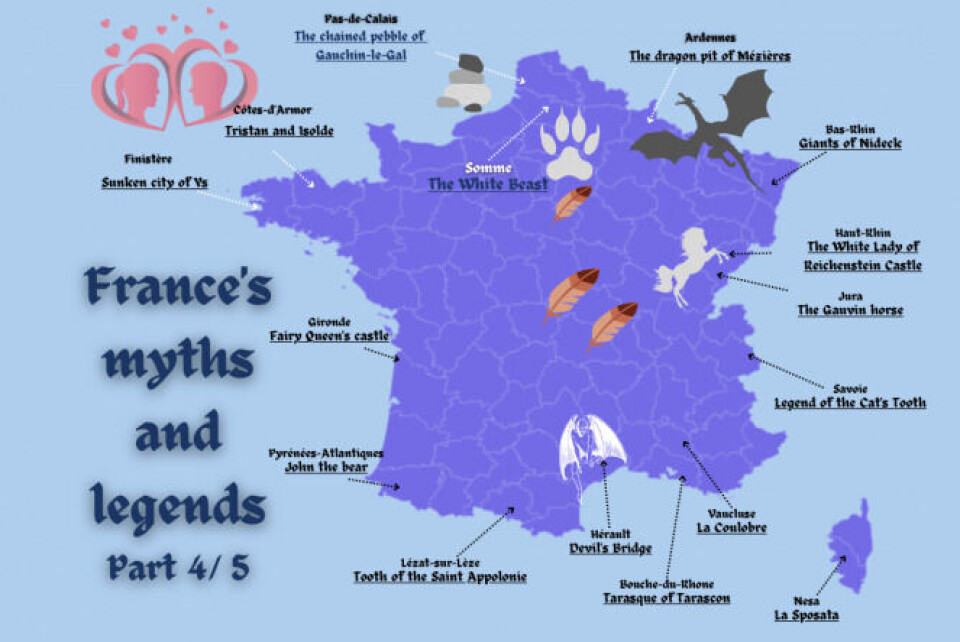-
Why magical Montpellier is one of France’s most appealing cities
Discover the sun-filled southern city that boasts medieval architecture, a laid-back, creative vibe, along with a packed cultural calendar
-
Discover the five most iconic French songs everyone loves
From Charles Aznavour to Edith Piaf – find out which tunes made the list
-
French gardening tips for November: bird feeders, potager tasks, and sustainable gifts
Seasonal advice to enhance your garden's beauty and productivity
French legends part four: Bluebeard and bears – stories from the west
We continue our myths and legends’ series with a look west to a sunken city, the origins of Bluebeard and the popular tale of John the bear

This is the fourth part of a five-part series. In the next installations we will look at legends from the centre of France.
You can read part one of the series here: French legends part 1: Beasts and beauty - stories from the north
Part two of the series here: French legends part two: Giants and ghosts – stories from the east
And part three of the series here: French legends part three: Devils & dentists – stories from the south

Bluebeard
Bluebeard is a classic French folktale about a despicable murderer with, unsurprisingly, a blue beard.
The tale goes that he marries a series of women who all then go missing.
He then gets married again to a woman called Cadette. Some time after the wedding, Bluebeard announces that he has to go away on a trip of several weeks. He leaves Cadette at his home with a set of keys.
He tells her that she absolutely must not go into his office.
But Cadette was curious and decided to go into the office. There, to her horror, she sees the bodies of Bluebeard’s former wives, hung up on the wall. In shock, she drops the key on the floor.
Bluebeard returns earlier than expected and notices a blood stain on the key to his office. He immediately understands what has happened and goes to kill Cadette, but luckily her brothers arrive and kill Bluebeard first.
The story has different versions but the most famous one that still survives was written by Charles Perrault and was published in 1697.
While the tale comes from folklore, it is believed that it is based on a real 15th-century Frenchman called Gilles de Rais. He was at one point the Marshal of France and fought alongside Joan of Arc.
But he was later accused of sexually abusing and brutally murdering possibly hundreds of children, for which he was tried as a witch and killed.
Gilles de Rais was born in Maine-et-Loire and died in Nantes (Brittany).
The sunken city of Ys
The sunken city of Ys is a classic Breton tale.
The story goes that King Gradlon, a revered 5th-century warrior, had a daughter named Dahut, whom he greatly loved.
At his daughter's request, he had a city built below sea level and protected by large dykes. The city was named Ys.
Everyone in the city was extremely happy with it being well protected from external dangers - but Dahut was a bit of a hothead and every night she invited a man to the city for some late night fun.
She would ask them to put a mask on and in the morning, when they woke up, the mask would suddenly ram spikes into their skulls, killing them.
But one day, a foreign prince arrived in the city and Dahut became besotted with him. She decided not to ask him to wear the mask. So charmed was she by him that she also gave the man the key to the city.
That was a mistake because he turned out to be none other than the devil who had come to punish Dahut for her sins.
The disguised devil used the key to open the city gates and the city was swallowed up by the sea, lost forever.
John the Bear
The tale of John the Bear, or Jean de l’Ours is widely known in France around the Pyrénées region where bears once lived and have been reintroduced again.
It tells of a young, beautiful woman who one day was kidnapped by a bear and locked in its den. Over time, she got used to the situation (an early case of Stockholm syndrome?) and agreed to have a child with the bear.
The child was named John, or Jean, and was half bear and half man.
As John grew older he became stronger and one day he managed to escape the bear’s den along with his mother. He then went on to have a series of adventures in the world of humans, often using his super-strength to overcome challenges.
There are several different versions of this tale, each with different twists or origins.
The above map and article is also part of our ongoing series showcasing different elements of French society and culture.
We have also written about French inventors, cheeses, funny commune names, local sweets and desserts, local aperitifs and many other topics.
If you have any suggestions for maps you would like us to make or think we should add anything to our previous articles, let us know at news@connexionfrance.com.
Related articles
Five French stories that mix history and myth - from Caesar to Clovis
Urban myth or true: Is it illegal to call a pig Napoleon in France?
Truth or myth?: Napoleon and the story of the truncated pyramid cheese
























